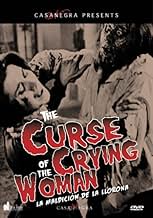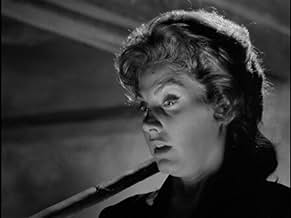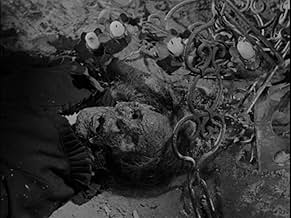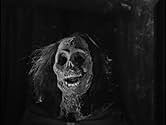NOTE IMDb
6,5/10
862
MA NOTE
Ajouter une intrigue dans votre langueAfter fifteen years of being away, a woman returns with her husband to her aunt's hacienda in the Mexican countryside, without realizing that her relative is a sorceress who wants to use her... Tout lireAfter fifteen years of being away, a woman returns with her husband to her aunt's hacienda in the Mexican countryside, without realizing that her relative is a sorceress who wants to use her to bring an evil witch back to life.After fifteen years of being away, a woman returns with her husband to her aunt's hacienda in the Mexican countryside, without realizing that her relative is a sorceress who wants to use her to bring an evil witch back to life.
- Réalisation
- Scénario
- Casting principal
Carlos López Moctezuma
- Juan
- (as Carlos Lopez Moctezuma)
Avis à la une
This Mexican made horror flick is said to be based on an old Mexican legend called "The Crying Woman." However, this film has little to do with the legend and is essentially an original story about a women who comes to a haunted mansion to claim an inheritance and is plagued by the ghost of a dead woman and a rotting corpse that comes to life. Some descriptions claim the woman is a descendant of the original crying woman, but I saw no mention of this in video copy I saw. Perhaps this was removed when the film was prepared for English language release by K. Gorden Murray. I understand that there is a more faithful version of the original legend filmed in Mexico in 1930's.
Great atmospheric Mexican horror film! Some special effects are sloppy, but the music and sets are true to the genre. The appearances of the crying woman (la llorana) herself are truly some of the most extremely unnerving moments in a horror film. Worth seeing just for that. The film is best seen in its original Spanish version.
As ever when finally getting a viewing of a film I've been looking forward to, I was worried that The Curse of the Crying Woman may not live up to expectations; but this exquisite slice of Mexican Gothic horror lived up to them all, and then some! Comparisons with the great Mario Bava's masterpiece "Black Sunday" are obviously going to come about, and this story of ancient curses and witchcraft is similar to the earlier sixties film in many ways. The most striking aspect of the film is undoubtedly the atmosphere, and director Rafael Baledón succeeds in creating a foreboding tone throughout the movie, which blends extremely well with the folklore origins of the story. The film is based on the Mexican legend 'La Llorona', and centres on a supposedly cursed mansion in the middle of the woods. We follow Amelia; a young woman who travels to see her Aunt Selma's with her husband. However, it soon becomes apparent that Selma has become obsessed with an ancient witch, whose power she believes can be unlocked by Amelia. People say that the woods are haunted by the crying woman, and Amelia is about to find out a truth to that legend!
It's quite unbelievable that a film of this quality could remain incognito for so long, and full credit must go to Casa Negra for their excellent DVD release. I'm coming to realise that Mexico produced a lot of cheap horror films throughout the sixties and seventies; many of which can't stand tall with the best that the more accomplished nations have to offer, but this is surely one of the very best films to come out of the South American nation. Rafael Baledón's direction is superb, and the outdoor scenes that see the woods and central house surrounded in fog could be framed and hung on the wall, such is their beauty. The film is packed with obscure and fascinating support characters, including the decayed corpse of the witch, which somehow takes on a life of its own, the maniacal servant and deformed family member that is kept in the attic! The conclusion to the film is superb, and the director's use of a huge bell is excellently handled and helps to deliver the scintillatingly Gothic finale that the film deserves. Overall, we horror fans should count ourselves lucky that there are DVD release companies willing to take a chance on unknown films like this one, and every horror fan must see The Curse of the Crying Woman!
It's quite unbelievable that a film of this quality could remain incognito for so long, and full credit must go to Casa Negra for their excellent DVD release. I'm coming to realise that Mexico produced a lot of cheap horror films throughout the sixties and seventies; many of which can't stand tall with the best that the more accomplished nations have to offer, but this is surely one of the very best films to come out of the South American nation. Rafael Baledón's direction is superb, and the outdoor scenes that see the woods and central house surrounded in fog could be framed and hung on the wall, such is their beauty. The film is packed with obscure and fascinating support characters, including the decayed corpse of the witch, which somehow takes on a life of its own, the maniacal servant and deformed family member that is kept in the attic! The conclusion to the film is superb, and the director's use of a huge bell is excellently handled and helps to deliver the scintillatingly Gothic finale that the film deserves. Overall, we horror fans should count ourselves lucky that there are DVD release companies willing to take a chance on unknown films like this one, and every horror fan must see The Curse of the Crying Woman!
"La Maldición De La Llorana" aka. "The Curse of the Crying Woman" (1963) is a haunting and absolutely ingenious little treasure of Mexican Gothic Horror cinema, that simply has to be seen by anybody interested in Horror. In spite of an obviously low budget, director Rafaél Baldedón accomplished to create a film of incredibly eerie atmosphere and genuine creepiness that represents all the great qualities we love in Gothic Horror film. In some parts clearly inspired by Mario Bava's milestone "La Maschera Del Demonio" ("Black Sunday", 1960, which is probably my choice for THE greatest Horror film ever made), "La Maldicion De La Loorana" is a stroke of genius of its own right that mesmerizes like few other films.
"La Llorana" (the 'Crying Woman') is apparently a classic character of Latin-American folk tales, and has been the theme of several other Mexican Horror films; As far as I know, however, the 'Crying Woman' in this film has very little resemblance to the folk story character. The film begins magnificently creepy when the passengers of a stagecoach passengers fall victims to a gruesome encounter. Shortly thereafter, newlyweds Jaime (Abel Ferrara) and his young wife Amelia (Rosa Arenas) come to the area in order to visit Amelia's aunt Selma (Rita Macedo). Amelia notices that her beautiful but mysterious aunt, who lives in an eerie mansion, has not aged a day since she last saw her as a child... "La Maldición De La Llorana" is an absolutely awesome classic Gothic tale of witchcraft, curses and resurrection that simply has everything my fellow fans of Gothic Horror so love about this kind of cinema. Incredibly eerie settings and macabre set-pieces, such as an eerie mansion, dark tombs and secret passages, a captivating score, ingeniously creepy makeup and, not least, a delightfully macabre and haunting story make this an absolute must for every Horror lover to see. This one's budget wasn't high, but director Baledón made the best out of it, and proves once again that it doesn't need a vast sum of money in order to make a film look and feel magnificently creepy. Beautiful Rita Macedo is great and eerie in her role and Rosa Arenas fits greatly in the role of the innocent beauty. Abel Salazar, who plays the husband may be recognized for playing the title role in the wonderfully trashy gem "El Barón Del Terror" (1962) and prolific Mexican actor Carlos López Moctezuma shines in the role of the sinister servant. The film also includes a small appearance of Julissa, who would later star alongside Boris Karloff in some of the Horror deity's very odd last films.
It seems as if my enthusiasm for Mexican Horror films is growing with each film I see, and though I regrettably cannot (yet) claim to be an expert on the field, I can say that, judging by the films I've seen so far, Mexico of the 1960s was a great country for Gothic tales. Though it my have some minor flaws, "La Maldición De La Llorana" is a downright brilliant film that ranges only slightly below the absolute masterpieces of 60s Gothic cinema, such as Antonio Margheriti's "Danza Macabra", Roger Corman's Poe-films with Vincent Price or anything that Mario Bava made. This little masterpiece, as well as the equally brilliant Mexican Goth-Horror gem "Misterios De Ultratumba" ("Mysteries From Beyond The Grave"), is deliciously creepy beyond belief, and an absolute must-see for all Horror fans to see. Very Highly Recommended!
"La Llorana" (the 'Crying Woman') is apparently a classic character of Latin-American folk tales, and has been the theme of several other Mexican Horror films; As far as I know, however, the 'Crying Woman' in this film has very little resemblance to the folk story character. The film begins magnificently creepy when the passengers of a stagecoach passengers fall victims to a gruesome encounter. Shortly thereafter, newlyweds Jaime (Abel Ferrara) and his young wife Amelia (Rosa Arenas) come to the area in order to visit Amelia's aunt Selma (Rita Macedo). Amelia notices that her beautiful but mysterious aunt, who lives in an eerie mansion, has not aged a day since she last saw her as a child... "La Maldición De La Llorana" is an absolutely awesome classic Gothic tale of witchcraft, curses and resurrection that simply has everything my fellow fans of Gothic Horror so love about this kind of cinema. Incredibly eerie settings and macabre set-pieces, such as an eerie mansion, dark tombs and secret passages, a captivating score, ingeniously creepy makeup and, not least, a delightfully macabre and haunting story make this an absolute must for every Horror lover to see. This one's budget wasn't high, but director Baledón made the best out of it, and proves once again that it doesn't need a vast sum of money in order to make a film look and feel magnificently creepy. Beautiful Rita Macedo is great and eerie in her role and Rosa Arenas fits greatly in the role of the innocent beauty. Abel Salazar, who plays the husband may be recognized for playing the title role in the wonderfully trashy gem "El Barón Del Terror" (1962) and prolific Mexican actor Carlos López Moctezuma shines in the role of the sinister servant. The film also includes a small appearance of Julissa, who would later star alongside Boris Karloff in some of the Horror deity's very odd last films.
It seems as if my enthusiasm for Mexican Horror films is growing with each film I see, and though I regrettably cannot (yet) claim to be an expert on the field, I can say that, judging by the films I've seen so far, Mexico of the 1960s was a great country for Gothic tales. Though it my have some minor flaws, "La Maldición De La Llorana" is a downright brilliant film that ranges only slightly below the absolute masterpieces of 60s Gothic cinema, such as Antonio Margheriti's "Danza Macabra", Roger Corman's Poe-films with Vincent Price or anything that Mario Bava made. This little masterpiece, as well as the equally brilliant Mexican Goth-Horror gem "Misterios De Ultratumba" ("Mysteries From Beyond The Grave"), is deliciously creepy beyond belief, and an absolute must-see for all Horror fans to see. Very Highly Recommended!
While not quite in the same league as THE BLACK PIT OF DR. M (1958) or THE WITCH'S MIRROR (1960), this is yet another fine addition to the great - and largely unheralded - series of classic Mexican horror films. This was actually the fourth of at least five vintage films about the titular creature (in the last of these, she was even pitted against another Mexican legend - Santo the wrestler!): it would be great if the others were revived - no pun intended - as well somewhere along the line by Casanegra or whomever.
Again, the film positively drips with atmosphere and style (belying the miniscule budget on hand) - generally coming off as unmistakably Mexican but also borrowing freely from other horror titles, most notably Mario Bava's seminal BLACK Sunday (1960). As in THE WITCH'S MIRROR - which, incidentally, shared with this film its star Rosita Arenas, producer Abel Salazar (here he essayed the role of the male lead as well) and composer (the ubiquitous Gustavo Cesar Carrion) - weird mirror imagery plays an essential part in the narrative, as does witchcraft, for that matter. The scarred 'monster' of that film as well as THE BLACK PIT OF DR. M, then, is incarnated here not by one but three different figures - The Crying Woman herself, decomposed and awaiting re-animation; her disciple Rita Macedo's hulking and club-footed henchman; and Macedo's once-distinguished husband, whom she has kept locked up for years and who has consequently regressed to a subhuman, animal-like level. Also on hand is a trio of rather skinny-looking Great Danes, which are unleashed from time to time to attack unsuspecting villagers or intruding police officials.
Two of its most compelling sequences are those in which Macedo recounts to Arenas and Salazar (individually) the tale of the "Llorona"; the latter has little real purpose, but its depiction of the events is done through brief snippets of scenes (shown in negative) from other Salazar-produced horror films - I immediately noticed the only shot I'm familiar with up to this point, from THE WITCH'S MIRROR, but shots from THE BRAINIAC (1961; which is next in my Halloween horror marathon!) are included as well, as per the Commentary; besides, here we get an unexpected but effective display of sensuality - which is felt again when Arenas (already in the process of replacing the "Llorona") notices Salazar's bloodied hand. Among the film's indelible images are all the scenes in which the eyes of The Crying Woman's disciples turn completely black - an effect seen in the very first shot and which was later lifted by INVASION OF THE BEE GIRLS (1973); Macedo's bat-like swoop towards the camera and Arenas' hallucination (which is as expressionistic as they come, with the night sky being crammed with staring accusing eyes) are also worth mentioning and striking, too, is the distinctive make-up design for each of the 'monsters'.
The busy climax - in which Salazar and Carlos Lopez Moctezuma (the henchman) engage in a lengthy and energetic fist-fight, and the long-suffering husband Domingo Soler finally gets even with Macedo, as the hacienda collapses around them - is quite splendid. Also notable here is the lighting when the 'possessed' Arenas attempts to liberate the "Llorona" by removing a stake from her body (a scene which, unfortunately, is absurdly over-extended so as to allow the huge bell in the impressive bell-tower set at the top of the mansion - as important to this film as it was to Hitchcock's VERTIGO [1958] - to chime 12 times!). The film features a generous number of effective shock moments and some rather graphic violence for the time: the scene where a girl - played by Macedo's real-life daughter, billed as Julissa del Llano - is trampled by a carriage; one where the pitiful and half-crazed Soler is brutally whipped by the sadistic Moctezuma, until he retaliates (a scene which is heavily reminiscent of Dwight Frye's tormenting of Boris Karloff in James Whale's FRANKENSTEIN [1931]); and especially the dogs' vicious attack on the two constables (sections of which were reportedly trimmed for export versions).
Regrettably, the Audio Commentary for this release turned out to be a major disappointment: not only is there a great deal of dead air on this track, with Michael Liuzza (Casanegra's Vice President, no less!) allowing several of the best scenes to go without comment but, when he does speak, he mainly resorts to biographical details of the various personnel involved!!
Again, the film positively drips with atmosphere and style (belying the miniscule budget on hand) - generally coming off as unmistakably Mexican but also borrowing freely from other horror titles, most notably Mario Bava's seminal BLACK Sunday (1960). As in THE WITCH'S MIRROR - which, incidentally, shared with this film its star Rosita Arenas, producer Abel Salazar (here he essayed the role of the male lead as well) and composer (the ubiquitous Gustavo Cesar Carrion) - weird mirror imagery plays an essential part in the narrative, as does witchcraft, for that matter. The scarred 'monster' of that film as well as THE BLACK PIT OF DR. M, then, is incarnated here not by one but three different figures - The Crying Woman herself, decomposed and awaiting re-animation; her disciple Rita Macedo's hulking and club-footed henchman; and Macedo's once-distinguished husband, whom she has kept locked up for years and who has consequently regressed to a subhuman, animal-like level. Also on hand is a trio of rather skinny-looking Great Danes, which are unleashed from time to time to attack unsuspecting villagers or intruding police officials.
Two of its most compelling sequences are those in which Macedo recounts to Arenas and Salazar (individually) the tale of the "Llorona"; the latter has little real purpose, but its depiction of the events is done through brief snippets of scenes (shown in negative) from other Salazar-produced horror films - I immediately noticed the only shot I'm familiar with up to this point, from THE WITCH'S MIRROR, but shots from THE BRAINIAC (1961; which is next in my Halloween horror marathon!) are included as well, as per the Commentary; besides, here we get an unexpected but effective display of sensuality - which is felt again when Arenas (already in the process of replacing the "Llorona") notices Salazar's bloodied hand. Among the film's indelible images are all the scenes in which the eyes of The Crying Woman's disciples turn completely black - an effect seen in the very first shot and which was later lifted by INVASION OF THE BEE GIRLS (1973); Macedo's bat-like swoop towards the camera and Arenas' hallucination (which is as expressionistic as they come, with the night sky being crammed with staring accusing eyes) are also worth mentioning and striking, too, is the distinctive make-up design for each of the 'monsters'.
The busy climax - in which Salazar and Carlos Lopez Moctezuma (the henchman) engage in a lengthy and energetic fist-fight, and the long-suffering husband Domingo Soler finally gets even with Macedo, as the hacienda collapses around them - is quite splendid. Also notable here is the lighting when the 'possessed' Arenas attempts to liberate the "Llorona" by removing a stake from her body (a scene which, unfortunately, is absurdly over-extended so as to allow the huge bell in the impressive bell-tower set at the top of the mansion - as important to this film as it was to Hitchcock's VERTIGO [1958] - to chime 12 times!). The film features a generous number of effective shock moments and some rather graphic violence for the time: the scene where a girl - played by Macedo's real-life daughter, billed as Julissa del Llano - is trampled by a carriage; one where the pitiful and half-crazed Soler is brutally whipped by the sadistic Moctezuma, until he retaliates (a scene which is heavily reminiscent of Dwight Frye's tormenting of Boris Karloff in James Whale's FRANKENSTEIN [1931]); and especially the dogs' vicious attack on the two constables (sections of which were reportedly trimmed for export versions).
Regrettably, the Audio Commentary for this release turned out to be a major disappointment: not only is there a great deal of dead air on this track, with Michael Liuzza (Casanegra's Vice President, no less!) allowing several of the best scenes to go without comment but, when he does speak, he mainly resorts to biographical details of the various personnel involved!!
Le saviez-vous
- AnecdotesThere have been many film adaptations of the legend, including a 1933 version that is believed to be the first Mexican horror film.
- ConnexionsEdited from Le baron de la terreur (1962)
Meilleurs choix
Connectez-vous pour évaluer et suivre la liste de favoris afin de recevoir des recommandations personnalisées
- How long is The Curse of the Crying Woman?Alimenté par Alexa
Détails
- Date de sortie
- Pays d’origine
- Langue
- Aussi connu sous le nom de
- The Curse of the Crying Woman
- Lieux de tournage
- Société de production
- Voir plus de crédits d'entreprise sur IMDbPro
- Durée
- 1h 20min(80 min)
- Couleur
- Rapport de forme
- 1.37 : 1
Contribuer à cette page
Suggérer une modification ou ajouter du contenu manquant


























